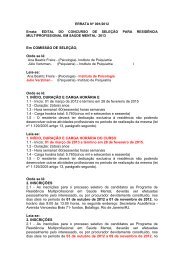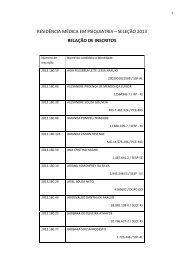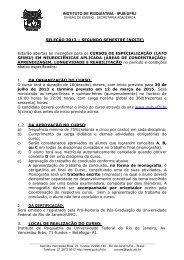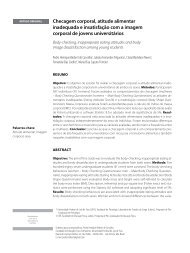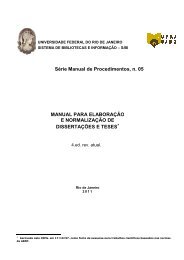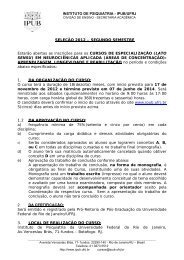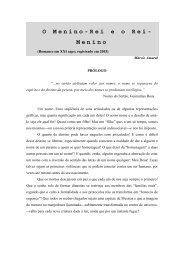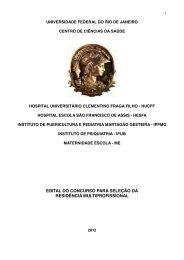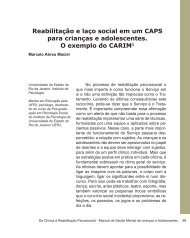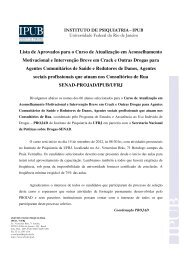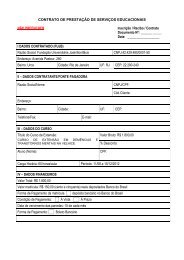Originais â Originals outubro | dezembro ⢠2011 - IPUB - UFRJ
Originais â Originals outubro | dezembro ⢠2011 - IPUB - UFRJ
Originais â Originals outubro | dezembro ⢠2011 - IPUB - UFRJ
You also want an ePaper? Increase the reach of your titles
YUMPU automatically turns print PDFs into web optimized ePapers that Google loves.
304 King ALS et al.<br />
ORIGINAL ARTICLE<br />
xiety (AA) and agoraphobic avoidance (PA-aa) 7 are clarified.<br />
Patients have the custom of myths in relation to PA, including<br />
but not limited to: the patient is instructed to question<br />
and contest his or her conjectures and beliefs, concentrate<br />
on realistic probabilities, and gather evidence and formulas<br />
to deal with events.<br />
Eighth session: The IE refers to the fear learned from internal<br />
states. Certain sensations of terror, similar to previously<br />
experienced fear, may precipitate new Pas 6 . The automatic<br />
stimulus generated intensifies the feared sensations, creating<br />
a vicious circle. Conduct two SIEs: first, the patient sits<br />
down and places their head between their legs for 30 seconds,<br />
after which they sit up quickly and look to the ceiling.<br />
Second, the patient holds their breath until it can no longer<br />
be held while turning around in circles for 30 seconds. In<br />
continuity, analysis of the symptoms and trying to understand<br />
the originating causes. RR exercise is conducted.<br />
Ninth session: Conduct three SIEs: first, repeat the SIE<br />
from the 5 th session. Then follow the first SIE with the two<br />
SIEs from the 8 th session. Subsequently conduct the RR exercise.<br />
The purpose for the patient is to associate the symptom<br />
with the cause. Explain that the symptoms emerge from<br />
physiological alterations triggered for some reason, and that<br />
BS do not emerge from nowhere, with no apparent reason.<br />
Before CBT, the patient would make distorted associations<br />
of facts, interpreting tachycardia, perspiration, and loss of<br />
breath, among others, as signs of imminent death or loss of<br />
control, and not as resulting from specific triggering factors.<br />
Tenth session: Conduct one SIE: the patient standing<br />
up and turns his or her head from side to side for 30 seconds,<br />
stops, and tries to fix his or her eyes on a spot on the wall.<br />
Repeat this exercise after the SIE from the third session, in<br />
continuity; recover the patient’s physical balance and respiration<br />
with RR or PMR exercises. Evaluate the IVE concept regarding<br />
confronting the patient with agoraphobic situations<br />
or locations. Real confrontation with the feared situation was<br />
repeated with each item on the priority list of each patient’s<br />
fears, beginning with the least anxiety-provoking and culminating<br />
with the most feared. Patients were asked to practice<br />
IVE whenever possible. The IVEs conducted were reviewed,<br />
practical repetitions were encouraged, and difficulties in the<br />
procedures were discussed with each patient.<br />
The therapist stimulated thoughts concerning the avoided<br />
tasks and helped the patients with CR. The fact was<br />
commented upon that additional diagnostics, including comorbidities<br />
such as depression, generalized anxiety and social<br />
phobia, tended to decline after PD treatment. The therapist<br />
also reaffirmed that the fear response was inoffensive,<br />
passing, and controllable, and that BS appear and disappear<br />
and do no need to be actively avoided.<br />
After the end of all the stages of the research, the two<br />
groups were re-evaluated with the same initial instruments.<br />
The groups were compared, and the changes that had occurred,<br />
relative benefits, losses, and differences between the<br />
two groups were observed and documented.<br />
Statistical analysis<br />
Inferential analysis of the results was undertaken by means of<br />
Chi-square tests for several categories and analysis of variance<br />
(ANOVA) for the continuous variables, considering the<br />
differences between the averages of the scores obtained by<br />
the participants at the beginning and the end of treatment,<br />
in each of the separate evaluator instruments. In the characterization<br />
of the groups, the tests were undertaken with the<br />
values identified at the beginning of treatment. Thus, the<br />
effi ciency of the initiatives undertaken could be perceived.<br />
The confidence interval was arbitrated at 95% and p-valu es<br />
≤ 0.05 were considered significant. Data processing and<br />
analysis were conducted using SPSS software (version 14.0).<br />
RESULTS<br />
Patient characteristic<br />
Table 1 presents the socio-demographic and clinical features<br />
of the general population and clinical comorbidity (both<br />
groups).<br />
Administered pharmacotherapy: in the intervention<br />
group 44% of patients were using TAD and 56% used SSRI,<br />
while in the control group we observed 64% of patients with<br />
TAD and 36% with SSRI.<br />
Age of the participants<br />
Group 1 and group 2 (control) differed significantly in age.<br />
The minimum age for both groups was 22 and the maximum<br />
was over 55 years old. However, the average age for the<br />
group 1 was 44.5 (standard deviation, SD = 12.8; confidence<br />
interval (CI) (95%) = 39.0 – 49.8) and for the Control group<br />
(2) was 33.7 (SD = 9.6; CI (95%) = 29.7-37.7). The analysis of<br />
variance (ANOVA) test of means showed 0.000 significance,<br />
which is lower than the p – value 0.05, with 95% confidence.<br />
Test results<br />
At the end of the study, cardio-respiratory symptoms, PAs,<br />
anticipated anxiety, agoraphobic avoidances and fear of BS<br />
were significantly reduced in group 1 compared to group<br />
2 (Table 2). In the global assessment of functioning scale,<br />
group 1 increased its overall well-being from 60.8 to 72.5,<br />
while overall well-being in group 2 progressed, but to a<br />
slightly lesser extent, 66.0% to 71.3%. In the respiratory<br />
subtype 21 PAs, the following respiratory symptoms were<br />
prominent during PAs: sensation of suffocation, respiratory<br />
difficulty, paresthesias, dizziness, and fear of death 22 . It was<br />
observed that 77.6% of the surveyed patient population<br />
presented the respiratory subtype and 22.4% presented the<br />
non-respiratory subtype.<br />
J Bras Psiquiatr. <strong>2011</strong>;60(4):301-8.




